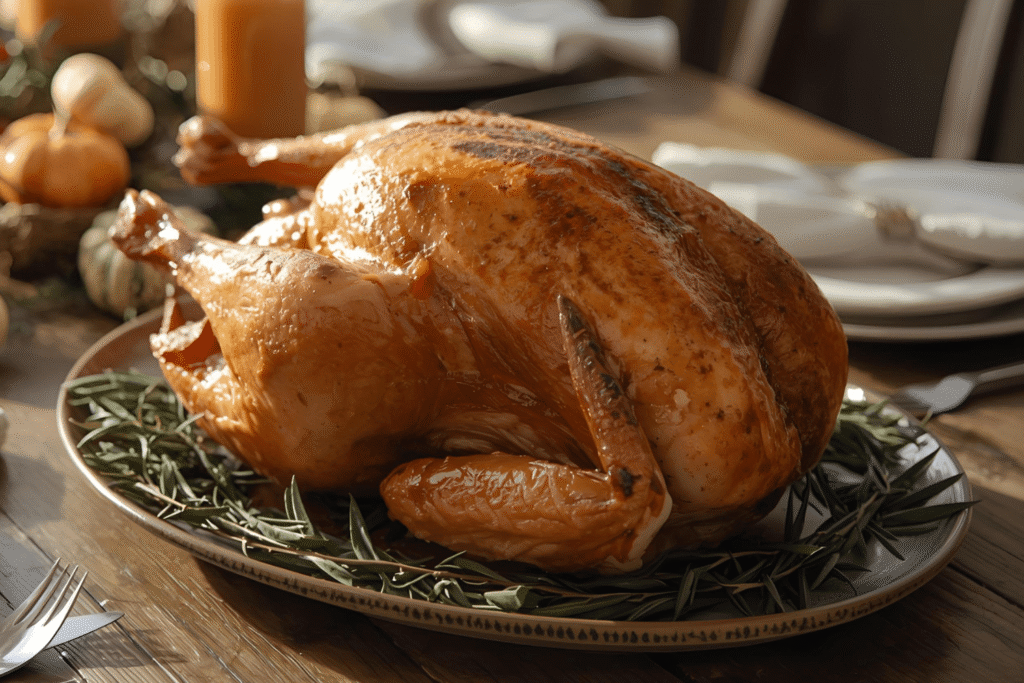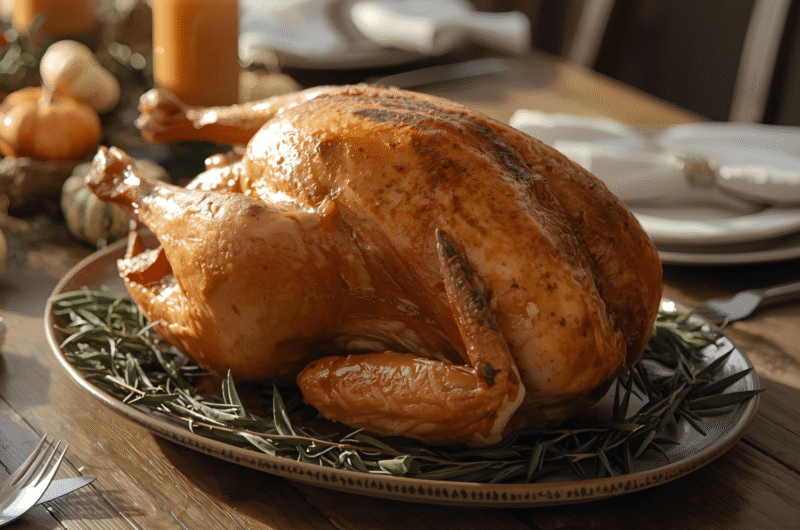When the calendar flips to late November, the centerpiece that everyone anticipates is turkey. Around 85% of Americans serve turkey at Thanksgiving, and it’s easy to see why.
It’s not just tradition, turkey brings community, comfort, and a sense of celebration. With one beautifully roasted bird, you get flavor, plenty of meat, and leftovers that last for days.
For many young hosts, pulling off the perfect turkey feels like a holiday milestone. It’s your moment to impress family and friends with a meal that feels festive yet effortless.
Pro Tip: While your turkey is roasting, the kitchen smells amazing, take advantage of that downtime to set the table, light candles, or pour yourself a glass of wine.
Choosing your turkey’s size, fresh vs frozen, whole vs breast
Before diving into recipes and rubs, start with the basics: which turkey to buy and how much you’ll need.
How much turkey per person
A good rule of thumb is 1 pound of turkey per person if you want everyone satisfied with moderate leftovers.
If your guests love leftovers (and who doesn’t?), plan for 1½ pounds per person.
For larger groups, consider roasting two smaller turkeys instead of one giant one. They cook faster and more evenly, and you get more crispy skin to go around.
Fresh vs frozen
Fresh turkey:
- Convenient, no thawing required.
- Often juicier, but more expensive.
- Needs to be purchased 1–2 days before roasting.
Frozen turkey:
- Budget-friendly and widely available.
- Just make sure you plan thawing time correctly.
- Ideal for those prepping ahead.
Whole turkey vs turkey breast
A whole turkey gives you both white and dark meat and that picture-perfect presentation. A turkey breast, on the other hand, is easier and faster to cook, perfect for smaller gatherings or Friendsgiving dinners.
Prep and safety basics
A successful Thanksgiving turkey starts with good prep. Handling and thawing safely prevents any last-minute panic and ensures your bird is juicy, flavorful, and safe to eat.
Ingredients

- 1 whole turkey (14–16 lbs for 10–12 guests)
- ½ cup unsalted butter, softened
- 2 tablespoons olive oil
- 1 lemon, halved
- 1 head of garlic, halved
- 1 onion, quartered
- 2 sprigs each of fresh rosemary, thyme, and sage
- Salt and freshly ground black pepper, to taste
- ½ cup softened butter mixed with minced garlic, chopped herbs, paprika, and lemon zest (for rubbing under the skin)
- Fresh herbs, citrus slices, and a handful of cranberries for garnish
Thawing safely
If using a frozen turkey, thaw it in the fridge, not on the counter. Plan for 24 hours of thawing per 4–5 pounds of turkey.
If you’re short on time, you can use the cold-water method: submerge the turkey (in its packaging) in cold water, changing the water every 30 minutes. This takes about 30 minutes per pound.
Food safety and temperature
Keep raw turkey separate from other foods and wash your hands and utensils thoroughly after handling it.
When cooking, aim for an internal temperature of 165°F (74°C) in the thickest part of the bird. That’s your golden number for a perfectly cooked, safe turkey.
Pro Tip: A meat thermometer is your best friend. It takes out the guesswork and guarantees a perfectly roasted turkey every single time.
Seasoning and flavoring your turkey
Seasoning is where your turkey goes from “good” to legendary. You can keep it classic or try something bold, but the key is adding flavor inside and out.
Dry brine vs wet brine
- Wet brine: Involves soaking the turkey in a saltwater solution with herbs, sugar, and citrus for 12–24 hours. It’s great for moisture retention but requires a large container and fridge space.
- Dry brine: Rubbing salt (and sometimes herbs) directly onto the turkey’s skin and letting it rest uncovered in the fridge overnight. This method saves space, crisps up the skin beautifully, and enhances flavor just as well.
Pro Tip: Dry brining overnight is easier, cleaner, and gives you that crisp golden skin everyone raves about.
Herbs, butter, and rubs
Herbs like thyme, rosemary, and sage are Thanksgiving staples. Combine them with softened butter, garlic, lemon zest, and black pepper for a fragrant herb butter.
Gently separate the turkey skin and rub the butter underneath, it locks in moisture and seasons the meat from within.
If you want extra flair, sprinkle paprika for color or brush on a honey-butter glaze during the last 30 minutes of roasting for a glossy, golden finish.
Cooking methods and timing
No matter which technique you choose, the key to a successful Thanksgiving turkey is patience.
Traditional oven roast
Roasting is the most common method and produces that classic holiday aroma.
- Preheat your oven to 325°F (163°C).
- Roast for 13 minutes per pound for an unstuffed bird.
- If your turkey is stuffed, plan for around 15 minutes per pound.
To check for doneness, insert a thermometer into the thickest part of the thigh without touching bone. Once it hits 165°F, you’re good to go.
Pro Tip: Don’t rely on pop-up timers that come with some turkeys. They’re often inaccurate, trust your thermometer instead.
Alternative methods
- Oven bag: Locks in steam and shortens cooking time while keeping the meat juicy.
- Foil tent: Cover the turkey loosely with foil for the first half of roasting, then remove it to crisp the skin.
- Spatchcock method: Removing the backbone and flattening the turkey cuts roasting time dramatically and ensures even cooking.
If you’re looking for a hands-off method, you can also try slow roasting overnight or using an air fryer for smaller portions like turkey breast.
Carving, resting, and serving your turkey
Resting time
Once your turkey is done, resist the urge to slice immediately. Let it rest for at least 20–30 minutes under a loose foil tent. This helps the juices redistribute, ensuring every slice is tender and flavorful.
Carving tips
- Use a sharp carving knife and a sturdy cutting board.
- Remove the legs and thighs first, then slice the breast meat against the grain.
- Separate light and dark meat onto different platters so guests can pick their favorite.
Arrange the slices beautifully, garnish with fresh herbs or orange wedges, and serve on a warmed platter.
Pro Tip: Warm your serving platter in the oven (on low) before plating your turkey. It keeps the meat warm during serving.
Leftovers and creative uses
One of the best parts about Thanksgiving turkey? The leftovers. They’re basically bonus meals waiting to happen.
Here are some fun and delicious ways to use them:
- Turkey sandwiches with cranberry sauce and stuffing.
- Turkey pot pie loaded with veggies and creamy sauce.
- Turkey soup or ramen for cozy post-holiday meals.
- Turkey tacos or quesadillas with melted cheese and fresh salsa.
Store leftovers in airtight containers within two hours of serving. They’ll stay good in the fridge for up to 4 days or in the freezer for up to 3 months.
Pro Tip: Slice turkey before refrigerating. It cools faster and is easier to reheat without drying out.
Hosting tips for stress-free turkey cooking
- Start early, make a timeline for thawing, brining, and roasting.
- Prep your seasoning and butter the night before.
- Don’t overcrowd your oven, give your turkey room for airflow.
- Keep side dishes simple or make-ahead friendly.
- Let guests help with sides or drinks so you can focus on the bird.
Pro Tip: Use your phone timer to track each stage, from brining to basting. It keeps you organized and confident.
FAQs
You’ll need about 15 pounds of turkey for 10 guests. This allows generous servings and some leftovers.
It’s safer and easier to cook stuffing separately. When placed inside the bird, stuffing can prevent even cooking and increase food-safety risks.
Use butter under the skin, baste occasionally, and let it rest before carving. Avoid overcooking, remove it from the oven once it hits 165°F.
Yes! You can roast the turkey a day in advance, slice it, and store it in its juices. Reheat covered at 300°F until warm.
Cooked turkey lasts up to 4 days refrigerated or up to 3 months frozen.
Wrap it tightly in foil, cover it with a towel, and keep it in a warm oven (around 200°F). It’ll stay moist and ready for serving.
Baste your turkey every 30–45 minutes if you want that beautiful golden-brown skin and an extra boost of flavor. But don’t overdo it, opening the oven too often can lower the temperature and extend cooking time. If you’re using an oven bag or have brushed your turkey with butter beforehand, you can skip basting entirely and still get perfectly juicy results.
Final thoughts
Cooking a Thanksgiving turkey doesn’t have to feel like a daunting task. Once you understand the basics, choosing the right size, seasoning it well, and cooking to the perfect temperature, it’s surprisingly simple.
A well-cooked turkey is more than a meal. It’s a symbol of gathering, love, and gratitude. The aroma fills your home, the golden skin sparkles on the table, and the first slice brings smiles all around.
So take a deep breath, follow your plan, and trust your process. Whether it’s your first Thanksgiving hosting or your fifth, your turkey will shine as the heart of the holiday feast.
Pro Tip: Take a quick photo of your finished turkey before carving, it’s not just for Instagram, it’s a memory of your success.
12
servings30
minutes3
hours400
kcalA juicy, golden-brown Thanksgiving turkey that’s tender on the inside and perfectly crisp on the outside. Seasoned with fresh herbs, garlic, and lemon butter, this classic recipe guarantees flavorful results every time and the aroma alone will make your home feel like the holidays.
Ingredients
1 whole turkey (14–16 lbs)
½ cup unsalted butter, softened
2 tablespoons olive oil
Salt and freshly ground black pepper, to taste
1 lemon, halved
1 head of garlic, halved
1 onion, quartered
2 sprigs each of rosemary, thyme, and sage
½ cup softened butter mixed with minced garlic, chopped herbs, paprika, and lemon zest (for rubbing under the skin)
Fresh herbs, citrus slices, and cranberries for garnish
Directions
- Prep the turkey.
Pat the turkey dry with paper towels. Remove giblets if included. Let it rest at room temperature for about 30 minutes before seasoning. - Make the herb butter.
In a bowl, combine softened butter with minced garlic, rosemary, thyme, paprika, and lemon zest. Mix well until smooth and fragrant. - Season and stuff.
Rub olive oil and salt all over the turkey. Gently loosen the skin and spread the herb butter underneath. Stuff the cavity with lemon, garlic, onion, and fresh herbs. - Roast the turkey.
Preheat your oven to 325°F (163°C). Place the turkey breast-side up on a rack in a roasting pan. Roast for 13 minutes per pound, basting occasionally with pan drippings or melted butter. - Check for doneness.
The turkey is ready when the thickest part of the thigh reaches 165°F (74°C). Remove from the oven and tent loosely with foil. Let it rest for 25–30 minutes before carving. - Carve and serve.
Slice the turkey and arrange it on a platter. Garnish with fresh herbs, citrus slices, and cranberries. Serve with gravy and your favorite Thanksgiving sides.






